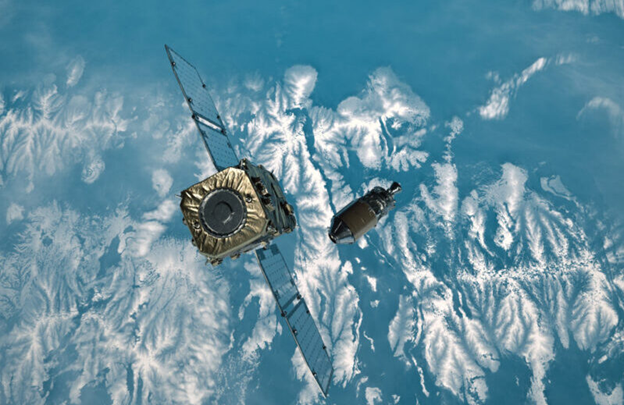Sustainability in Space
Rosie Braunholtz follows her 'Why Space?' article with this dive into the world of space sustsainability.
Introduction
Last month, space organizations from around the world gathered in Milan for the 2024 International Astronautical Congress (IAC)!
That is great timing as our previous article, “Why Space?, recently covered the basics on the space industry. Today’s article delves into the pressing issue of Space Sustainability. What happens to the thousands of satellites we send up there once they’re no longer in use? And what about the silent, defunct rovers on Mars?
This year the IAC's theme is “Responsible Space for Sustainability,”, and these questions were at the forefront. Global leaders discussed how we can keep our goals for landing humans on the Moon and Mars insight, while thinking about future generations and keeping our home, the Earth, safe.
The Congress brought together over 11,000 attendees, including space agency representatives, people in industry, scientists, and students, all focused on advancing sustainable exploration. Here we discuss some of the highlights of the whole week.
Orbital Debris and Low-Earth Orbit Sustainability

Image: Space Debris around Earth. Credit: ESA
One of the biggest concerns in space sustainability is space debris. Space debris is essentially human-made waste left in orbit around Earth. It includes defunct satellites, left over bits of rockets, fragments from collisions, and discarded tools or parts from human missions. The reason there is so much is due to people not having any plan for what to do with their leftover “junk” after the mission has been completed. Many satellites in the past being launched with no thought for what to do when they reach the end of their operational life. Leaving many dead satellites roaming around Earth’s orbit indefinitely. There are currently 3,356 inactive satellites orbiting Earth, representing 12.4% of all satellites in space. Occasionally collisions can happen in orbit due to the clutter (satellites orbit at very high speeds), and explosions can occur due to remaining fuel in dead satellites.
Obviously satellites are very important for climate change, global communications, weather, navigation and much more. But even the “alive” satellites orbits are getting a little bit crowded. Active satellites are having to perform an increasing number of collision avoidance maneuvers to dodge other satellites and debris and avoid being smashed into smithereens. All of this is becoming an increasing worry. If we continue in this way, it will soon start to become unsafe to launch astronaut missions, and certain orbits for satellites will be unusable, due to such limited (ironically) space.
 Image: The future number catastrophic collisions in Earth orbit, extrapolated based on a continuation of current behaviour and in the hypothetical event that there were no new launches as of 2024. Credit:ESA
Image: The future number catastrophic collisions in Earth orbit, extrapolated based on a continuation of current behaviour and in the hypothetical event that there were no new launches as of 2024. Credit:ESA
To address this, several agencies are setting new standards: for example, recent FCC regulations in the United States propose that dead satellites must de-orbit after five years post-mission. At the IAC, ESA and NASA shared plans for even stricter rules, as congestion in low-Earth orbit (LEO) has a huge risk to both current and future missions for both these space agencies.
A standout initiative at the IAC was ESA’s Zero Debris Charter, which aims to slow down the creation of new debris and advance technology which removes old debris. Many countries signed the initiative, from New Zealand to Mexico, and the Charter is quickly gaining traction. Over 100 organizations and 15 countries have endorsed this ambitious plan, and it marks a significant step toward a safer, more sustainable space environment.

Image: Signing of the Zero Debris Charter
Emerging Industry Solutions for Space Debris Management
While governments and big space agencies like ESA are working at a policy level, private companies are also trying to find solutions for managing the debris. Companies like Astroscale, ClearSpace, Northrop Grumman, and ALE Co. are actively developing technology to capture and remove space junk. Astroscale has made leaps in making technology that removes old satellites from orbit, while ClearSpace is under contract with ESA to remove specific debris. Northrop Grumman’s has developed a satellite service that extends the lifespan of satellites, reducing the need for replacements. Together, these companies are helping to build an industry around orbital maintenance and sustainability.

Image: Astroscale’s Space Debris removal. Astroscale has several missions designed to either extend a satellite’s life or safely remove the defunct satellite from orbit, by capturing it and then lowering it down into Earth’s atmosphere where it will safely burn up on re-entry.
Innovations in Sustainable Space Exploration
As well as sustainability around Earth’s orbit, there were lots of discussions about further exploration in space. Humans are trying to go to the Moon again, and soon. But the question is, how to do it ethically and sustainably?
The Artemis Accords are a set of international agreements led by NASA and supported by a few nations committed to sustainable lunar exploration. They layout rules for using resources responsibly, peaceful cooperation, and transparency. In their own words they are “Principles for a Safe, Peaceful, and Prosperous Future in Space”. Some key principles include assisting other nations in getting to space, responsibly managing debris, and sharing scientific data. The aim is to make sure humanity’s return to the Moon (and in the future, Mars) runs as smoothly as possible.
Both Japan and the UAE renewed their commitment at the 2024 IAC as well as others. This is significant as the Japanese space agency JAXA and the UAE are both planning for future lunar and asteroid exploration. Presentations from NASA, ESA, and other agencies also highlighted upcoming missions, space station projects, and interplanetary endeavors, all oriented around long-term sustainability.
The Artemis Accords hope to ensure that as humanity establishes a presence on the moon, activities are transparent and cooperative.

Image: Representatives of the Artemis Accords signatories, including NASA leadership, met Oct. 14, 2024, for a principals meeting in Milan, during the International Astronautical Congress. With 42 of 45 signatories participating in the event, established and emerging spacefaring nations from every region of the world were represented. Credit: UAE Space Agency
Public Engagement and Education on Space Sustainability
There were also many exhibits at the congress in Milan, featuring the many different ways the space industry helps us with climate change, by using satellites for Earth observation. Earth observation is extremely important for tackling climate change as stated in our previous article “Why Space?”, and having the public understand and supporting this is essential to sustainable space efforts.
One of the travelling exhibitions attending the congress was Space for Our Planet. This fantastic exhibit showcased testimonials from global experts—including climate scientists, artists, doctors, and astronauts—and highlighted how space technology benefits life on Earth.
The testimonials include audio interviews, images and text. In total 35 'agents of change' shared their experiences on how space is providing a solution to achieve the United Nations' 17 Sustainable Development Goals (SDGs). Through these exhibits, the public learns about the way space science helps and informs environmental management on Earth.

Image: Algal Bloom swirls, Baltic Sea, Copernicus Sentinel-2 mission, Plankton has a major influence on the amount of carbon in the atmosphere and are sensitive to environmental changes. Satellites are able to monitor them for future climate change models. Credit ESA
Conclusion
The 2024 IAC successfully brought together people from all around the world to address one of the most important issues facing space exploration today: sustainability! They addressed many different topics from changing important space policy to advancing debris-removal technologies, and lastly the conference highlighted how important working together on shared commitments is to achieving our sustainable goals.
Author: Rosie Braunholtz
















